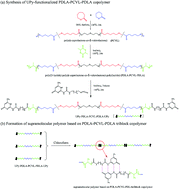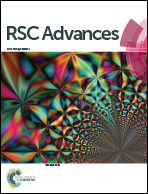Crystallization, rheology and mechanical properties of the blends of poly(l-lactide) with supramolecular polymers based on poly(d-lactide)–poly(ε-caprolactone-co-δ-valerolactone)–poly(d-lactide) triblock copolymers†
Abstract
In this study, we investigated the blending of poly(L-lactide) (PLLA) with supramolecular polymers based on poly(D-lactide)–poly(ε-caprolactone-co-δ-valerolactone)–poly(D-lactide) (PDLA–PCVL–PDLA) triblock copolymers as an efficient way to modify PLLA. The supramolecular polymers (SMP) were synthesized by the terminal functionalization of the PDLA–PCVL–PDLA copolymers with 2-ureido-4[1H]-pyrimidinone (UPy). The structure, thermal properties and rheological behavior of the synthesized supramolecular polymers were studied; we found that the formation of the UPy dimers expanded the molecular chain of the polymer and the incorporation of the UPy groups suppressed the crystallization of polymers. In addition, the synthesized supramolecular polymers had a low glass transition temperature of about −50 °C, showing the characteristics of elastomers. On this basis, superior properties such as a fast crystallization rate, high melt strength, and toughness of fully bio-based, i.e., PLA-based materials were achieved simultaneously by blending PLLA with the synthesized supramolecular polymers. In the PLLA/SMP blends, PLLA could form a stereocomplex with its enantiomeric PDLA blocks of supramolecular polymers, and the stereocomplex crystals with the cross-linking networks reinforced the melt strength of the PLLA/SMP blends. The influences of the SMP composition and the SMP content in the PLLA matrix on crystallization and mechanical properties were analyzed. The supramolecular polymers SMP0.49 and SMP1.04 showed a reverse effect on the crystallization of PLLA. Tensile tests revealed that the lower content of the synthesized supramolecular polymers could achieve toughening of the PLLA matrix. Therefore, the introduction of supramolecular polymers based on PDLA–PCVL–PDLA is an effective way to control the crystallization, rheology and mechanical properties of PLLA.



 Please wait while we load your content...
Please wait while we load your content...